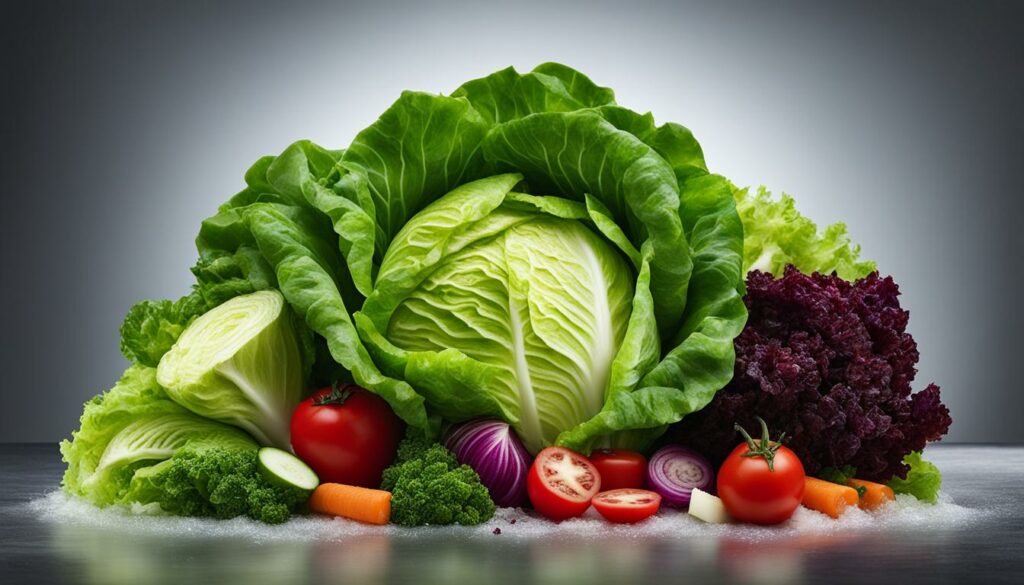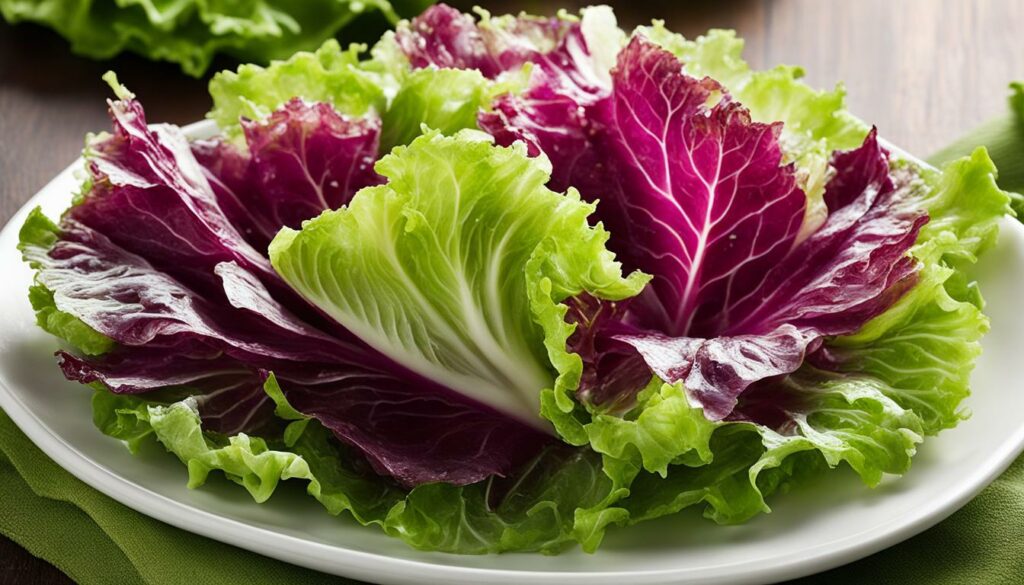Iceberg lettuce, also known as crisphead lettuce, is a popular choice for its crisp texture and mildly sweet flavor. Despite being considered less nutritious than other lettuce varieties, iceberg lettuce offers several important health benefits.
It is packed with vitamin A, vitamin K, and folate. Vitamin K helps with blood clotting, while vitamin A supports eye health. Folate is crucial for fetal development, making it a recommended choice for pregnant women.
Key Takeaways:
- Iceberg lettuce is a popular choice for its crisp texture and mild flavor.
- Despite being less nutritious than other lettuce varieties, iceberg lettuce offers important health benefits.
- It is rich in vitamin A, which supports eye health.
- Vitamin K in iceberg lettuce helps with blood clotting.
- Folate in iceberg lettuce is essential for fetal development.
Nutritional Value of Iceberg Lettuce
When it comes to nutritional value, iceberg lettuce may not be as nutrient-dense as darker greens, but it still offers important health benefits. This crisp and refreshing lettuce is low in calories, with just 10 calories per cup of shredded lettuce, making it an excellent choice for those watching their calorie intake. Let’s explore the essential nutrients found in iceberg lettuce:
| Nutrient | Amount per cup (shredded) |
|---|---|
| Vitamin A | 361 IU |
| Vitamin C | 1.5 mg |
| Calcium | 15 mg |
| Iron | 0.2 mg |
| Vitamin K | 17.4 mcg |
| Folate | 15.2 mcg |
These nutrients contribute to overall health and wellbeing. Vitamin A, for example, supports eye health and may help prevent age-related vision loss. Meanwhile, vitamin C acts as an antioxidant, protecting the body against damage from harmful free radicals.
Calcium and iron are essential minerals that support bone health and red blood cell production, respectively. Vitamin K is crucial for blood clotting, and folate plays a vital role in fetal development, making it especially beneficial for pregnant women.
Although iceberg lettuce may not offer the same robust nutrient profile as darker greens like spinach or kale, it can still be a valuable addition to a healthy diet.
To maximize its nutritional benefits, consider combining iceberg lettuce with other salad greens, such as romaine, spinach, or arugula. This way, you can enjoy a wide range of nutrients while adding a crispy, refreshing element to your meals.

Health Benefits of Iceberg Lettuce
Iceberg lettuce provides several health benefits that make it a valuable addition to your diet. Rich in essential nutrients, it offers support for blood clotting, eye health, and fetal development. Let’s explore the specific benefits of including iceberg lettuce in your meals:
Vitamin K for Blood Clotting
Iceberg lettuce is a great source of vitamin K, a crucial nutrient that plays a key role in blood clotting. Individuals with bleeding disorders or liver disease can benefit from including more vitamin K in their diet. By consuming iceberg lettuce, you can ensure your body has an adequate supply of this important vitamin.
Vitamin A for Eye Health
The vitamin A content in iceberg lettuce contributes to maintaining healthy eyes and may help prevent age-related vision loss. By incorporating iceberg lettuce into your meals, you can support your eye health and enjoy the benefits of this essential vitamin.
Folate for Fetal Development
Folate, also known as vitamin B9, is necessary for fetal development, especially during the first trimester of pregnancy. Iceberg lettuce contains folate, making it a recommended choice for pregnant women.
Including iceberg lettuce in your diet can help ensure sufficient folate intake to support proper fetal growth and development.
Incorporating iceberg lettuce into your meals can offer these important health benefits. Its crisp texture and mild flavor make it a versatile ingredient that can be enjoyed in various dishes.

“Iceberg lettuce provides essential vitamins and minerals that support overall health. Incorporate it into your diet for its nutrient-rich benefits.”
How to Incorporate Iceberg Lettuce into Your Diet
Iceberg lettuce is a versatile ingredient that can be enjoyed in numerous ways. Not only does it add a refreshing crunch to your dishes, but it also offers a delightful mild flavor that complements various flavors. Here are some ways you can incorporate iceberg lettuce into your diet:
Tacos and Wraps
Add a layer of crispy iceberg lettuce to your tacos or wraps for extra texture and freshness. Whether you’re making classic beef tacos or a vegetarian wrap, the crispiness of the lettuce will elevate your dish.
Burgers and Sandwiches
Instead of relying solely on traditional lettuce leaves, amp up the flavor and texture of your burgers and sandwiches by using iceberg lettuce. Its crispness will provide a satisfying crunch with every bite.
Pasta Salads
Iceberg lettuce can also be a great addition to pasta salads. Chop it into bite-sized pieces and mix it with your favorite pasta, dressing, and other veggies for a refreshing and nutritious meal.
When using iceberg lettuce, it’s important to ensure you handle it properly. Here’s a step-by-step guide:
- Wash the iceberg lettuce leaves thoroughly to remove any pesticides or dirt.
- Cut off the base of the lettuce bulb, as it can be too hard to eat.
- Use a knife to chop the lettuce into the desired size.
| Ways to Eat Iceberg Lettuce | Recipes with Iceberg Lettuce |
|---|---|
| Tacos | Greek Salad |
| Wraps | Lettuce Wraps |
| Burgers | Asian Chicken Salad |
| Sandwiches | Classic Wedge Salad |
| Pasta Salads | BLT Salad |
Explore these recipes and get creative with iceberg lettuce to enhance the flavor and texture of your meals. Enjoy the crisp and refreshing benefits of this versatile lettuce variety!
Conclusion
In conclusion, the crisp and mildly sweet iceberg lettuce may not boast the same nutrient density as its leafy green counterparts, but it still brings significant health benefits to the table.
With its vitamin A, vitamin K, and folate content, iceberg lettuce supports blood clotting, promotes eye health, and aids in fetal development. While it’s recommended to combine iceberg lettuce with other salad greens for a more well-rounded nutritional profile, incorporating this refreshing lettuce into your diet can be a nutritious choice.
Don’t overlook the advantages of including iceberg lettuce in your favorite dishes. Whether it’s adding a satisfying crunch to tacos and burgers, or enhancing the texture of sandwiches and wraps, iceberg lettuce brings a delightful crispness to meals.
Remember to wash the leaves thoroughly before use and remove the tough base of the lettuce bulb for optimal enjoyment.
So, seize the opportunity to savor the health benefits of iceberg lettuce. Its goodness in vitamin A, vitamin K, and folate make it a viable option for supporting blood clotting, maintaining eye health, and promoting healthy fetal development.
Transform your meals with the crisp and nutritional benefits of iceberg lettuce, and relish the nutritious addition it brings to your plate.
FAQ
What are the health benefits of eating iceberg lettuce?
Iceberg lettuce offers several health benefits. It is packed with vitamin A, vitamin K, and folate, which support eye health, blood clotting, and fetal development, respectively.
Is iceberg lettuce nutritionally valuable?
While iceberg lettuce may not be as nutrient-dense as darker greens, it still contains essential nutrients such as vitamin A, vitamin C, calcium, iron, vitamin K, and folate, contributing to overall health and wellbeing.
How is iceberg lettuce good for the body?
Iceberg lettuce is rich in vitamin K, which supports blood clotting. It also contains vitamin A, promoting eye health, and folate, crucial for fetal development. These properties make it beneficial for individuals with bleeding disorders, liver disease, and pregnant women.
How can I incorporate iceberg lettuce into my diet?
Iceberg lettuce is versatile and can be enjoyed in various ways. It adds a refreshing crunch to tacos, burgers, sandwiches, wraps, and pasta salads. Just remember to wash the leaves thoroughly before use and remove the hard base of the lettuce bulb before chopping.








